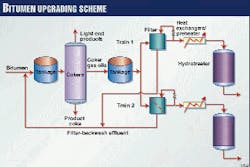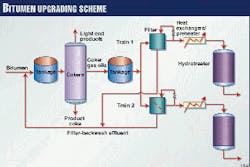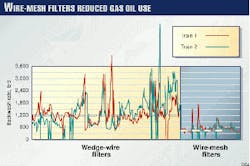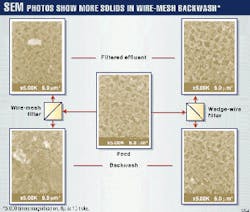Retrofitted hydrotreater feed filters reduce operating cost, waste handling
Retrofitting hydrotreater-feed filters with wire-mesh filters significantly reduced the operating cost at Syncrude Canada Ltd.'s Alberta oilsands plant. It also improved the specification of solids in the coker gas-oil feed.
The plant originally used wedge-wire filters in this service. After testing wire-mesh filters in a laboratory-scale model of the plant, Syncrude decided to use them.
Feed filtration removes solid contaminants that cause plugging of fixed-bed catalyst processes. To improve process efficiency, many refineries have feed-filtration systems. Filtration equipment allows refineries more flexibility in feedstock handling and extension of unit run-lengths.1-3
Traditionally, the selection of filtration systems for refinery processes is based on standard industry practice and information provided by equipment vendors. Many solid contaminants in petroleum streams are not well defined, however, and filtration technology is empirical in nature.4
Feasibility tests before actual application, such as Syncrude used here, allow optimization of the filtration system.
Experience
Syncrude operates a surface-mining oilsands plant in northern Alberta and produces Syncrude Sweet Blend (SSB) synthetic crude oil from the oilsands bitumen. A detailed Syncrude operation is described in another article (OGJ, June 28, 1999, p. 44).
Two fluid cokers upgrade most of the bitumen. Reactors hydrotreat the coker products, which consist of naphtha and gas oils, to remove sulfur and nitrogen (Fig. 1).
Refiners historically use backwash wedge-wire filters (a conventional feed filter used in refinery operations) to remove coke fines in coker gas-oil feed to the fixed-bed hydrotreaters.1 The operating principle of the backwash filtration system is described elsewhere.1 3
The filters use a split stream of filtered gas oils to backwash the filters. The effluent of filter backwash goes to a bitumen feed tank. The coking process then removes the solids in the filter backwash effluent as part of product coke.
Since plant start-up in 1978, Syncrude production capacity has increased substantially. By 1993, each hydrotreater, which was designed for 45,000 b/d, processed 60,000 b/d of coker gas oils.
At that time, the wedge-wire filters experienced excessive backwashing frequency. In some instances, the backwashing was incessant and used up to 6,000 b/d of gas oil to backwash the filters. This resulted in a significant loss in gas oils and increased frequency of ex situ steam cleaning of filters.
Consequently, Syncrude investigated the state of the existing backwash wedge-wire filtration system to identify options to reduce operating costs and waste handling in removing solids from coker gas oils.
Filter test
Syncrude used a pilot-filtration test skid and a laboratory-scale, filter-drawdown test unit to simulate the commercial backwash-filter operation. The pilot test used coker gas oil from the commercial plant.
The laboratory-drawdown test used diesel with silicious ACCTD (Arthur Champion Coarse Test Dust) to simulate solids in coker gas oil. The drawdown test unit was equipped with an in-line particle counter. The flow rate of test fluid was scaled according to the commercial flow rate (gpm/sq ft) of the filter area.
Pressure drop build-up data were obtained at various flow rates of coker gas oils. Syncrude analyzed the feed and filtrate samples from each run to determine the solids contents. The experiment used scanning electron microscopy (SEM) to examine the clean filter and deposits on filter at various times during the filtration cycle.
Test results were consistent with expected results. The filter gap opening of the 25-mm nominal wedge-wire filter varied from 7 to 80 mm with a 7% void area. More importantly, the SEM analysis of the deposits on filter showed that the wedge-wire filtration system works like a strainer; no filter cake was found.There was no noticeable reduction in solids loading in the test fluids. The solids removed by the wedge-wire filters were relatively large particles. This is consistent with field experience. Rapid pressure drop build-up in the wedge-wire filtration system was a result of plugging of filter gap openings, which resulted in high backwashing frequency.
A sensitivity test determined the effects of flow rate and solids (loading and particle-size distribution) on filtration-cycle time. The results showed that increased flow rate or solids loading reduced filtration-cycle time.
In the case of increasing flow rate, the shortening of filtration-cycle time was as a result of an increase in the baseline-pressure drop, as expected.
Solids loading and particle-size distribution (PSD), however, had a more pronounced effect than flow rate. Thus, the loading and PSD caused rapid pressure drop build-up, which shortened the filtration-cycle time dramatically.
Syncrude concluded that options for improving the existing wedge-wire filters operation were limited. Consequently, it extended the filter test program to explore the feasibility of other nonconventional filters.
Filter selection criteria
After a preliminary test with several filters, the company selected a 25-mm nominal sintered wire-mesh filter with 40% void area as a potential replacement. The selection criteria were as follows.- Longer filtration cycle, hence lower backwash frequency and less gas oil required for backwashing.
- Solids loading in filtered coker gas-oil feed is less than or equal to that in the existing system.
- Ease of filter regeneration during backwash and ex situ cleaning.
- Ease of retrofitting with the existing hardware.
- Capable of handling 25% more throughput capacity.
- At least a 5-year lifetime.
The selected wire-mesh filters were subjected to the filter tests outlined above. Engineering data determined plant implementation requirements.
Test results showed filter cake build-up on the wire-mesh filters during the filtration cycle. The filtration cycle time of the wire-mesh filters was six times longer than that of the wedge-wire filters at the scaled throughput rate of 60,000 b/d.
Syncrude developed a novel filter-backwash procedure. It uses a high-pressure surge to loosen the filter deposits; a low-flow backwash then rinses the filter elements. The latter results in a plug flow of backwash fluid, which effectively removes the suspended solids from the filter housings.
Wire-mesh filters significantly reduced the solids loading. In fact, as a result of filter cake build-up on wire-mesh filters, the filter efficiency increased during the filtration cycle. More, smaller particles were removed.
For economic considerations, Syncrude decided to retrofit the hydrotreater feed filtration system with the wire-mesh filters. To its best knowledge, Syncrude is the first in the refining industry to install wire-mesh filters in its refinery operations.
Retrofitting and field performance
Wire-mesh filters were installed during a spring 1995 turnaround.
Fig. 2 shows the history of the daily use of gas oil for backwashing hydrotreater feed filters from before and after retrofitting. The retrofit reduced the average amount of gas oil used by 60%.
At a typical reactor throughput rate of 60,000 b/d, about 700 b/d less backwash gas oil recycled to the bitumen feed tank. This represents a significant reduction in operating cost for the hydrotreater feed filters. Reducing the amount of backwash gas oil back to the bitumen feed tank also frees up the throughput capacity of the entire upgrading plant.
A back-to-back performance comparison of wedge-wire and wire-mesh filters was conducted during the spring 1995 turnaround. Retrofitting of the new wire-mesh filters on Trains 1 and 2 was staggered 2 weeks apart. Initially, wire-mesh filters were on Train 2, and wedge-wire filters were on Train 1.
The field data confirmed the previous pilot and laboratory test findings. The data showed wire-mesh filters to be more effective than wedge-wire filters in solids removal.
The filtrate stream of wire-mesh filters contained 50% less solids than that of wedge-wire filters; hence, it was not surprising to find the backwash stream of wire-mesh filters contained twice as much solids as the wedge-wire filters.
A comparison of PSD data shows that more of the larger particles remained in the outlet stream of wedge-wire filters than in the wire-mesh filters. The wire-mesh filters removed most of the particles greater than 10 mm, leaving primarily less than 10-mm particles in the outlet stream.Fig. 3 shows the SEM photos of the filterable solids from the filter streams. The background of these SEM photos are Pall 0.45-mm nylon NX filter media, which were used in determining the amount of solids in these samples. The foreground particles are filtered solids.A visual inspection shows that the amounts of solids were similar in all the wedge-wire filter streams. In the wire-mesh filters, only a few particles were found at the filter outlet. The amount of solids in the wire-mesh filter backwash effluent was so high that the background filter media was completely masked by the filtered solids.
Acknowledgments
Ann Garg and Paul Won coordinated the sampling of feed and filter streams. Chris Schroeter performed the pilot filtration tests. Tore Lindstrom of Pall Corp., Port Washington, N.Y., performed the laboratory filter drawdown tests and sample analyses.
References
- Reece, T.L., "Filters protect catalyst beds," Hydrocarbon Processing, September 1971, p. 161.
- Gardner, A., "Refining details: screens, strainers, filters," Today's Refinery, April 1995, p. 19.
- Wines, T.H., and Lindstrom, T.H, "Filtration can manage costly contaminants in refineries," OGJ, Apr. 26, 1999, p. 51.
- Masters, R.D., Campagna, Jr., W.J., and Hannifin, P., "Back to school: Filtration 101," Chemical Processing, August 1999, p. 45.
The Authors
Keng H. Chung is a research associate at the Edmonton Research Centre of Syncrude Canada Ltd. He also is an adjunct professor of chemical engineering at the University of Alberta and the University of Petroleum in China. He holds a BS, an MS from Queen's University, Kingston, Ont., and a PhD from the University of Calgary, all in chemical engineering.
Edwin Chan is a staff engineer with the upgrading technical team of Syncrude Canada Ltd. He has over 15 years' experience in bitumen upgrading, including trouble-shooting, process debottlenecking, optimization, and reliability. Chan holds a BS from the University of Alberta, Edmonton, and an MEng from the University of Western Ontario, London, both in chemical engineering.





